The September and October, we’re taking a look at the jam-packed 1994 to 1995 season of Star Trek, including Star Trek: Deep Space Nine and Star Trek: Voyager. Check back daily for the latest review.
The nineties comic book market was an interesting place. It enjoyed a huge boost due to the rise of speculation and collectors. The industry was massively successful in the early years of the decade, fuelled by high-profile artists, hype, and events. The industry imploded in on itself in the middle and towards the end of the decade, but it looked surprisingly profitable in the early years. Against that backdrop, Malibu Comics emerged.
Malibu had become the publisher of record for Image Comics in 1992. Image had been founded by a number of popular artists who had departed Marvel to set up their own shop and found their own company. Malibu distributed their comics for about a year, which gave Malibu access to a larger distribution platform. Although Image soon grew strong enough to publish its own comics, there was a point where Malibu had surpassed industry veteran DC Comics in the market place.
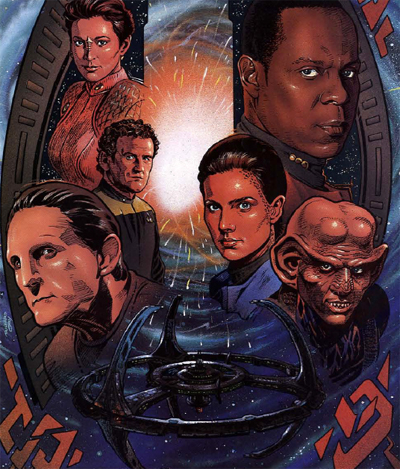
“Think of it—five months ago no one had ever heard of Bajor or Deep Space Nine. Now all our hopes rest here.”
Against this backdrop, Malibu secured the rights to publish comic books based on Star Trek: Deep Space Nine. Up until this point, DC comics had been publishing comics based on the original Star Trek and Star Trek: The Next Generation. Paramount’s decision to award the Deep Space Nine license to Malibu effectively split the comic book license up. DC Comics continued to publish comics based around the first two Star Trek shows, while Malibu had exclusive rights to the characters and world of Deep Space Nine.
As such, the decision to recruit writer Mike W. Barr and artist Gordon Purcell to write the first six issues of the comic was a pretty big deal. Barr and Purcell were incredibly associated with Star Trek comic books. The duo had done popular work on the movie-era comics, and had demonstrated an obvious and abiding affection for the franchise. Assigning these two creators to work on Deep Space Nine was a very clear message. Malibu were taking this license very seriously, indeed.
In hindsight, this seems rather odd. Mike W. Barr and Gordon Purcell enjoy the most consistent and reliable run on Malibu’s thirty-two issue series. The comic ran from August 1993 through to December 1995, and featured the work of fourteen different writers and eight different pencillers. That is a pretty rapid changeover, one that makes Malibu’s Deep Space Nine comic seem more like an anthology than an on-going series.
So these first six issues seem anomalous. Mike Barr wrote five full issues, and a short story in the sixth issue. Gordon Purcell illustrated four of the first five issues. After that, Malibu rotated writers and artists through the book. When compared to the long runs enjoyed by writers like Howard Weinstein on Star Trek or Michael Jan Friedman on The Next Generation, this seemed a little strange. Nobody worked on Malibu’s Deep Space Nine comic long enough to establish a clear identity or direction for the book.
Nevertheless, hiring Mike W. Barr and Gordon Purcell sends the clear impression that Malibu considered Deep Space Nine an important comic. The first issue hit the stands in August 1993, in the gap between the first and second seasons of the television show. Given the type of deadlines that Barr was working under and production timeline for a comic issue, these comics would have been written very early in the life of the new Star Trek television show.
Although not rushed to the same extent as DC’s Star Trek: The Next Generation miniseries, there is a sense that Barr and Purcell have not really had a chance to see the see the show in action yet. There are a number of small moments that seem weird or out of place, reflecting the fact that Barr and Purcell were working from a very young television show. Given that Deep Space Nine did not really figure out what it wanted to be until Duet and In the Hands of the Prophets, this puts Barr and Purcell in an awkward position.
Odo suffers in particular. During Old Wounds, Odo is able to shape-shift to pass himself off as a Cardassian. Over the course of these first six issues, Odo is constantly moaning about his home and his mother, to the point that it plays like something of a joke. After one encounter with an alien matriarch in Emancipation, Bashir reflects, “She reminds me of my own mother.” Odo replies, “I wish she reminded me of mine.” Bashir wonders, “What?” Then, seemingly remembering Odo’s only character trait, realises, “Ah. Of course.”
Nevertheless, it is clear that Barr is watching the show and has been taking notes. He includes several shout-outs to early episodes, as if to establish his continuity bona fides. When Sisko visits Quark in Old Wounds, Quark idly observes, “If this is about the complaints from the Dabo Girl…” It is a clear shout out to the opening sequence from Captive Pursuit, where a dabo girl complains to Sisko about Quark’s conduct. When a dead body turns up in a holosuite, Odo references A Man Alone. “This is the Ibudan case all over again.”
Sisko is even shrewd enough to recognise the type of plot devices that had established themselves on Deep Space Nine. When a bunch of green mould threatens to take over the station in Stowaway, Sisko is quick to suspect the mysterious artefacts that just came through the wormhole on a Federation starship. After all, even the first season had established that any object coming through the wormhole was seldom good news – in episodes like Q-Less, The Foresaken or even Dramatis Personae.
However, Barr very cleverly seems to recognise the core strengths of Deep Space Nine as a television show. In particular, he seems identify that Deep Space Nine will be an ensemble show. The first arc, Stowaway, is prompted by the actions of Jake Sisko and Nog during a field trip as part of Keiko’s school. Gul Dukat shows up to menace the station, and Bashir even consults with Garak about a possible solution to the situation. (Rom even makes a cameo at the end of the story.)
In hindsight, this seems rather obvious. After all, there are points in the series where Marc Alaimo and Andrew Robinson seem more like series regulars than Cirroc Lofton. However, the ensemble actually developed very slowly over the course of the first season. Garak only appeared in one episode, Past Prologue. Dukat only appeared in two episodes, Emissary and Duet. So the fact that Barr recognises this tendency and impulse in his first two-part story arc is a testament to his skill.
Outside of Odo, Barr’s characterisation works quite well. There are lots of little touches that work. Kira and Sisko find themselves frequently at odds, as was often the case in the first two seasons. At points, Kira even seems to be subverting Sisko’s authority. “Never contradict me in front of a hostile,” Sisko instructs Kira. “Are we clear?” As Odo’s security office comes under siege, Odo shape-shifts into a bird, but takes the time to save his bucket.
(Even the little touches ring true, such as the fact that Nog is terrified of taking responsibility for a mistake that he made. When Keiko and Dax discover that he and Jake broke a vial containing some chemical or other, Nog immediately panics. “Don’t hit me! Don’t hit –“ It’s an effective glimpse at Nog’s homelife as it appeared in the first season, suggesting that – behind Quark’s buffoonish exterior – there was something unpleasant at work.)
Barr’s run emphasises the differences between Deep Space Nine and the two shows that came before it. This is particularly notable, because the first season of Deep Space Nine struggled hard to balance its unique identity with the expectations of a Star Trek show. Barr only gets three storylines, but each of them feels uniquely tailored to the show’s station-board setting. They are stories that could not be told on The Next Generation without some serious revision and reworking.
Stowaway harks to Babel, with something left over on the station since the Occupation causing severe difficulties for the crew. Old Wounds is superficially quite similar to A Man Alone, featuring a locked-room mystery in a holosuite. However, Barr’s resolution to the mystery is quite clever and the mystery itself is juxtaposed against the return of a prominent Cardassian (“the butcher of Bajor”) to the station with his Bajoran wife. As such, it touches on ideas of legacy and collaboration and forgiveness.
Old Wounds and Emancipation both treat Deep Space Nine itself as a sort of limbo. It is a place constantly buzzing with activity, but one that feels like a stepping stone towards a final destination. It’s a fairly charming depiction of the station as a place where people are constantly coming and going, suggesting that Deep Space Nine could serve as a nexus of interesting stories that can begin and end far away from the station itself.
In Old Wounds, the Cardassian war criminal seeks to return to Bajor so that he might die there in peace. While the Bajoran Provisional Government refuses his request, they grant him leave to stay on Deep Space Nine. In Emancipation, a story arc that prefigures Sanctuary, a bunch of freed slaves come through the wormhole in search of their promised land. In both cases, Deep Space Nine itself is not the intended final destination, but a stopover along the way.
Barr seems to grasp that Deep Space Nine operates on a slightly different morality than that of The Next Generation. Even in the first season, it was a show with a less clear-cut morality. Emancipation is very much a Prime Directive story, but it is a deeply uncomfortable Prime Directive story as Sisko finds himself confronting an alien society that practices slavery. If Old Wounds harked back to A Man Alone, then Emancipation is Captive Pursuit.
There are all manner of uncomfortable issues raised here – from the question of whether terrorism conducted by an oppressed civilisation can ever be justified through to the awkward idea that individuals might actually be happier in slavery than they would be if freed. “Don’t you understand?” one freed slave explains to Sisko. “I don’t like being free!” It puts the crew of the station in an incredibly awkward position, one that is a lot less clear cut than the dilemmas that Picard and his crew usually faced.
(Barr gets bonus points for a delightfully on-the-nose-but-very-Star–Trek-ian sequence where Dax and Sisko discuss the situation through metaphor. Reflecting on plant samples taken from the Gamma Quadrant, Dax tells Sisko, “We found them growing in total darkness — deprived of light and water, almost everything a plant needs to survive. Yet they not only survived, they flourished.” It’s a surprisingly heart-warming reflection on the power of the spirit, which works because Barr doesn’t overplay it.)
Nevertheless, perhaps it is the final issue of Barr’s six-issue run that suggests the power of Deep Space Nine and teases the potential of the pseudo-anthology style that Malibu would adopt in publishing the comic. Barr only writes one of the three short stories featured within the comic. However, these three vignettes provide a broad glimpse at life on board the station, suggesting that Deep Space Nine is a place where all sorts of interesting short stories happen, and that these are well worth recording for posterity.
Gordon Purcell does great work on the comic. It is easy to see why Purcell was one of the go-to artists for licensed properties. Purcell has a wonderful knack for likeness, capturing a lot of the look and feel of Deep Space Nine as a television show. A monthly Deep Space Nine comic written by Barr and frequently illustrated by Purcell would have been a strong contender for the most consistent and interesting monthly Star Trek comic ever published. It is a shame that the duo were not able to stick around for longer.
Still, these opening six issues established that Malibu meant business with their Deep Space Nine comics.
You might be interested in our reviews of the second season of Star Trek: Deep Space Nine:
- The Homecoming
- Supplemental: Mike W. Barr and Gordon Purcell’s Run on Star Trek: Deep Space Nine (Malibu Comics)
- The Circle
- The Siege
- Invasive Procedures
- Cardassians
- Supplemental: The Never-Ending Sacrifice by Una McCormack
- Melora
- Rules of Acquisition
- Necessary Evil
- Supplemental: Terok Nor #0
- Second Sight
- Sanctuary
- Rivals
- The Alternate
- Armageddon Game
- Whispers
- Paradise
- Shadowplay
- Playing God
- Profit and Loss
- Blood Oath
- The Maquis, Part I
- The Maquis, Part II
- Supplemental: The Maquis – Soldier of Peace
- The Wire
- Supplemental: A Stitch in Time by Andrew J. Robinson
- Crossover
- Supplemental: Mirror, Mirror #1 – Fragile Glass
- Supplemental: The Next Generation – Dark Mirror by Diane Duane
- The Collaborator
- Tribunal
- The Jem’Hadar
Filed under: Comics, Deep Space Nine | Tagged: Comics, emancipation, fungus, gordon purcell, malibu comics, Mike W. Barr, old wounds, Slavery, star trek, star trek: deep space nine, stowaway |



















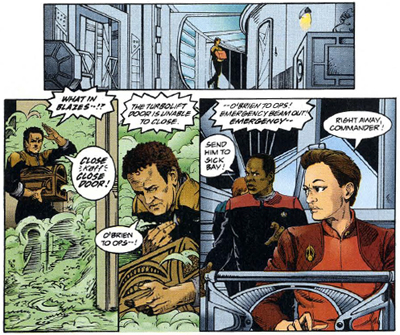
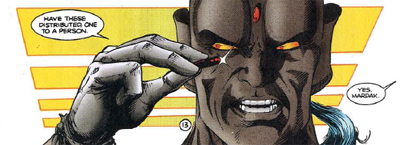
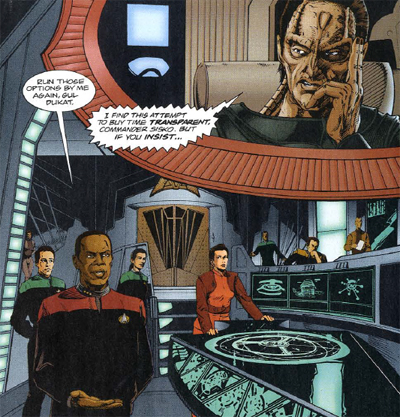


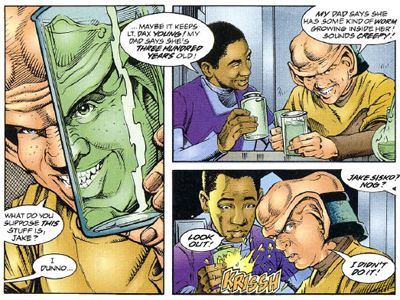






Leave a comment